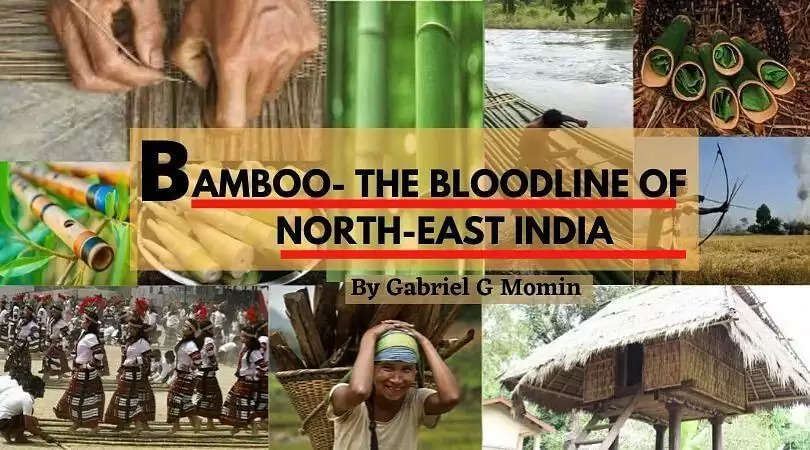Bamboo – The bloodline of North-East India

FEATURE | JUNE 17, 2020:
By Gabriel G Momin
As you travel across any of the Northeastern states, you'd hardly miss the sight of extensive bamboo groves; these evergreen perennial flowering plants are a depiction of nature's richness and uniqueness, a plant that can give you a feeling of immense freshness and calmness.
It will not be wrong to state that bamboo is an indispensable part of the lifeline of the tribal people in the Northeast. Its versatility makes it the tribal man's first choice, considering its strength and endurance while being a multi-purpose plant. It is formidable to imagine livelihood without bamboo because every aspect of tribal culture is intrinsically attached to bamboo. We would find that the region's culture is diverse in its food, values and norms, the rich folk tales and contrasting landscapes, and many more.
However, the entire region has one thing in common, and that is the close association with 'bamboo'.
Bamboo plays an important role in the preparation of food items and traditional cuisines; from blending raw bamboo shoot, fermented bamboo shoot to dry bamboo shoot, almost every tribe is familiar with these dishes.
For instance, Nagaland has the most exotic recipe like the mouth watery 'bamboo shoot pork' that is widely popular across the entire Northeast India and the world. The famous bamboo tube cooking is a very primitive method very dear to almost all the Northeastern tribes and to name a few, it is called 'brenga' amongst the Garo community and 'Sudu pant' amongst the Apatani tribe of Arunachal Pradesh.

Talking about the Mizos, the extremely energetic 'the Cheraw dance' is the first thing that comes to our mind. The sound of the bamboos, when clapped, forms the rhythm of the dance, indicating the timing of the dance as well.

It is all about art in Manipur. The tribes' engagement in bamboo crafts has not only helped preserve the inherited art and crafting skills but has also opened up various avenues for people to earn their livelihood.

Assam has the largest forest cover of bamboo in the country. The state also provides training on bamboo cultivation to boost 'Green Business'. Bamboo plays a significant role in tribal culture and their hunting skills. From bows and arrows for long-range shots and long spears to effective traps and fishing accessories, the applicability of bamboo in the crafting of hunting tools is widely popular amongst the tribes of Northeast.

If we talk about housing, it's a glaring sight that bamboos are extensively used by people especially in the rural areas. The pillars, walls floors for elevated types are built with bamboo as its main component. The kitchen items such as spoons, bowls, and cups are all made of bamboo. Tender bamboo stems are also favorable as ropes in binding. The beds, stools, tables, gates, fences, toilets, pigsty, chicken coops, cowsheds are all built using bamboo.

Traditional methods of farming are practiced widely and bamboos are used as hoes and yokes for cattle during sowing and harvesting season. For irrigation drainage and conservation, bamboo is very much favorable. The villages also build bridges with bamboo coupled with their unique designs. It also prevents soil erosion and keeps the soil intact.
Festivals are very vibrant among the northeastern tribes, attracting tourists from far and wide. Northeast exhibits a range of traditional practices, be it music, cultural heritage or the mysterious places with unusual stories.
Coming to sports, bamboos are being used by almost all the tribes; for instance 'pole climbing' and 'wa'pongsua' of the Garos. This is a game where two men hold the bamboo from two ends and exert pressure against each other to prove their might.
The tribes in Northeast are music lovers and one can witness a lot of musical instruments such as flutes and harps or the 'Chigring' commonly known among the Garo community as an idiophone instrument. The 'Olongma', a two-holed flute, and 'Il•lep', are some of the flutes found among the Garo community.
The list of Northeast's connection with bamboo is endless. Because of its abundance, its applicability and popularity in every sphere of the lives of the tribal, it is only apt to term this giant grass as the "bloodline" of tribes in Northeast India.

















